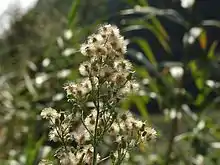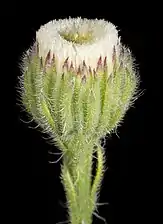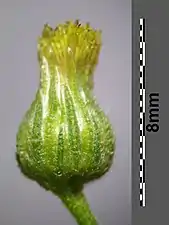Erigeron sumatrensis
Erigeron sumatrensis (syn. Conyza sumatrensis) is an annual herb probably native to South America, but widely naturalised in tropical and subtropical regions, and regarded as an invasive weed in many places.[1][2][3] In the British Isles it is known as Guernsey fleabane.[4] Other common names include fleabane, tall fleabane, broad-leaved fleabane, white horseweed, and Sumatran fleabane.
| Erigeron sumatrensis | |
|---|---|
 | |
| Fruiting | |
| Scientific classification | |
| Kingdom: | Plantae |
| Clade: | Tracheophytes |
| Clade: | Angiosperms |
| Clade: | Eudicots |
| Clade: | Asterids |
| Order: | Asterales |
| Family: | Asteraceae |
| Genus: | Erigeron |
| Species: | E. sumatrensis |
| Binomial name | |
| Erigeron sumatrensis | |
| Synonyms[1] | |
|
List
| |
Description
When fully grown (in summer or autumn), Erigeron sumatrensis reaches one to two metres in height. Flowers are white rather than purple-pink. Its leaves are like dandelion leaves, but longer, thinner and more like primrose leaves in colour and texture. Its seeding heads are like dandelions, but straw coloured and smaller.[5] In certain countries the plant has started to exhibit resistance to herbicides.[6]
Distribution
It probably originates from South America, but is now naturalised in North America, Europe,[7] Africa,[8] Asia,[9] and Australasia.[10] It poses a significant threat to wildlife conservation areas and other reserves. In Britain, of the non-native former Conyza species, it is the second most abundant (after Erigeron canadensis) and is typically found in London and the South East of England. It was first recorded in London by Brian Wurzell in 1984,[11] and noted in France at Saint-Sozy (Dordogne) in 2006.[12]
Gallery
References
- "Erigeron sumatrensis Retz". Plants of the World Online. Royal Botanic Gardens, Kew. Retrieved 23 August 2020.
- Flora of China, 苏门白酒草 su men bai jiu cao Erigeron sumatrensis Retzius
- Pruski, J.F. & G. Sancho. 2006. Conyza sumatrensis var. leiotheca (Compositae: Astereae), a new combination for a common neotropical weed. Novon 16(1): 96–101
- "BSBI List 2007". Botanical Society of Britain and Ireland. Archived from the original (xls) on 2015-01-25. Retrieved 2014-10-17.
- See pictures at International Environmental Weed Foundation
- Sumatran Fleabane, Weedscience.org
- Fleabane in Holland
- Flora of Zimbabwe: Conyza sumatrensis
- Sumatran Fleabane in Japan
- Pacific Island Ecosystems at Risk (PIER): Conyza sumatrensis
- "Fleabane in London". Archived from the original on 2011-06-04. Retrieved 2008-03-01.
- Mark Galliott (June 2006). "France – The Dordogne" (PDF). Tour Report. Naturetrek Wildlife Holidays. Archived from the original (PDF) on 2007-09-29. Retrieved 2011-10-18.
External links
| Wikimedia Commons has media related to Erigeron sumatrensis. |

.jpg.webp)
.jpg.webp)

